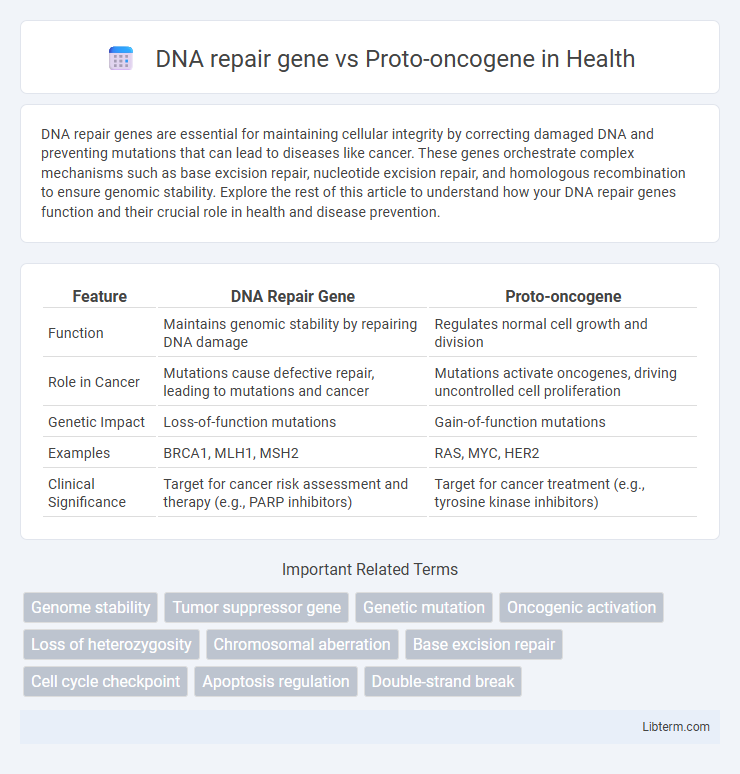DNA repair genes are essential for maintaining cellular integrity by correcting damaged DNA and preventing mutations that can lead to diseases like cancer. These genes orchestrate complex mechanisms such as base excision repair, nucleotide excision repair, and homologous recombination to ensure genomic stability. Explore the rest of this article to understand how your DNA repair genes function and their crucial role in health and disease prevention.
Table of Comparison
| Feature | DNA Repair Gene | Proto-oncogene |
|---|---|---|
| Function | Maintains genomic stability by repairing DNA damage | Regulates normal cell growth and division |
| Role in Cancer | Mutations cause defective repair, leading to mutations and cancer | Mutations activate oncogenes, driving uncontrolled cell proliferation |
| Genetic Impact | Loss-of-function mutations | Gain-of-function mutations |
| Examples | BRCA1, MLH1, MSH2 | RAS, MYC, HER2 |
| Clinical Significance | Target for cancer risk assessment and therapy (e.g., PARP inhibitors) | Target for cancer treatment (e.g., tyrosine kinase inhibitors) |
Introduction to DNA Repair Genes and Proto-oncogenes
DNA repair genes maintain genomic stability by correcting DNA damage and preventing mutations that could lead to cancer. Proto-oncogenes, when mutated or overexpressed, become oncogenes that drive uncontrolled cell proliferation and tumor development. Understanding the distinct roles of DNA repair genes and proto-oncogenes is crucial for cancer biology and targeted therapies.
Fundamental Roles in Cellular Function
DNA repair genes maintain genome integrity by correcting mutations that arise during DNA replication and from environmental damage, preventing genomic instability and mutagenesis. Proto-oncogenes regulate normal cell growth and differentiation by encoding proteins involved in signaling pathways, cell cycle progression, and apoptosis. Disruptions in DNA repair genes lead to increased mutation rates, while alterations in proto-oncogenes can result in uncontrolled cellular proliferation, both contributing to cancer development.
Mechanisms of DNA Damage and Repair
DNA repair genes encode proteins responsible for identifying and correcting damage in the DNA structure caused by environmental factors or cellular processes, maintaining genomic stability through mechanisms like base excision repair, nucleotide excision repair, and homologous recombination. Proto-oncogenes, on the other hand, primarily regulate cell growth and division, and when mutated, can disrupt normal cell cycle control, leading to oncogenesis but are not directly involved in DNA repair mechanisms. Mutations in DNA repair genes can result in accumulation of DNA damage, increasing the likelihood of proto-oncogene activation and subsequent cancer development.
Functions of DNA Repair Genes
DNA repair genes maintain genomic stability by identifying and correcting DNA damage caused by environmental factors or cellular processes, preventing mutations that could lead to cancer. Unlike proto-oncogenes, which regulate normal cell growth and proliferation, DNA repair genes ensure the integrity of genetic information by facilitating processes such as base excision repair, nucleotide excision repair, and mismatch repair. Dysfunction in DNA repair genes can result in accumulated DNA errors, increasing the risk of tumorigenesis and highlighting their critical role in cancer prevention.
Overview of Proto-oncogenes and Their Activation
Proto-oncogenes are normal genes that regulate crucial cellular functions such as growth, division, and differentiation but can become oncogenic through mutations or overexpression, leading to uncontrolled cell proliferation. Activation of proto-oncogenes occurs via point mutations, gene amplification, or chromosomal translocations, resulting in constitutively active proteins or aberrant signaling pathways that promote tumorigenesis. Unlike DNA repair genes that maintain genomic stability by correcting DNA damage, activated proto-oncogenes drive cancer progression by disrupting normal cellular regulatory mechanisms.
Mutation Impact: DNA Repair Genes vs. Proto-oncogenes
Mutations in DNA repair genes often lead to genomic instability by impairing the cell's ability to correct DNA damage, increasing the risk of cancer development. Proto-oncogene mutations typically result in gain-of-function changes that promote uncontrolled cell growth and tumor progression. While DNA repair gene mutations primarily cause loss-of-function effects hindering repair mechanisms, proto-oncogene mutations enhance signaling pathways that drive oncogenesis.
Inherited Disorders Linked to DNA Repair Gene Mutations
Inherited disorders linked to DNA repair gene mutations, such as Xeroderma Pigmentosum and Lynch syndrome, highlight the critical role of these genes in maintaining genomic stability. DNA repair gene defects impair the cell's ability to correct DNA damage, leading to increased mutation rates and a higher risk of cancer development. In contrast, proto-oncogenes are typically involved in cell growth regulation, and their mutations primarily lead to gain-of-function changes promoting uncontrolled cell proliferation.
Cancer Development and Proto-oncogene Dysregulation
DNA repair genes maintain genomic integrity by correcting DNA damage, preventing mutations that could lead to cancer, whereas proto-oncogenes regulate normal cell growth and division but can become oncogenes upon dysregulation, driving uncontrolled proliferation. Mutations or loss of function in DNA repair genes increase genomic instability, facilitating the accumulation of oncogenic mutations, including activation of proto-oncogenes. Dysregulation of proto-oncogenes through amplification, point mutations, or translocations promotes tumorigenesis by enhancing cell survival, proliferation, and metastasis.
Diagnostic and Therapeutic Implications
DNA repair genes are crucial for maintaining genomic stability by correcting DNA damage, with mutations in these genes often serving as diagnostic biomarkers for cancers such as BRCA1/2 in breast and ovarian tumors. Proto-oncogenes, when mutated to oncogenes, drive uncontrolled cell proliferation, making them important targets for molecular diagnostics and personalized therapies like tyrosine kinase inhibitors targeting EGFR or ALK mutations. Therapeutic strategies combining DNA repair gene inhibitors, such as PARP inhibitors, with targeted treatments against mutated proto-oncogenes enhance precision oncology by exploiting synthetic lethality and tumor-specific vulnerabilities.
Future Directions in Cancer Research: Targeting DNA Repair and Proto-oncogenes
Future cancer research increasingly targets DNA repair genes and proto-oncogenes to improve precision therapies and overcome resistance mechanisms. Advances in CRISPR-based gene editing and synthetic lethality approaches enable selective modulation of DNA repair pathways alongside proto-oncogene signaling disruptions. Integrating genomic profiling and proteomic data will facilitate personalized treatment strategies, enhancing efficacy in targeting these critical molecular drivers.
DNA repair gene Infographic

 libterm.com
libterm.com